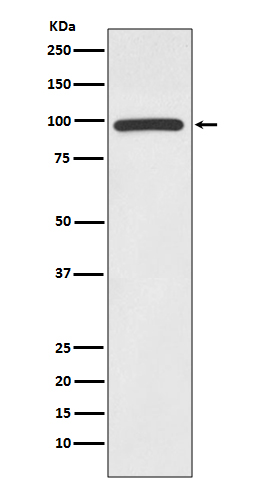
| WB | 1/500-1/1000 | Human,Mouse,Rat |
| IF | 1/20 | Human,Mouse,Rat |
| IHC | 咨询技术 | Human,Mouse,Rat |
| ICC | 技术咨询 | Human,Mouse,Rat |
| FCM | 咨询技术 | Human,Mouse,Rat |
| Elisa | 咨询技术 | Human,Mouse,Rat |
| Aliases | LDLCQ3 |
| Entrez GeneID | 3156 |
| WB Predicted band size | Calculated MW: 97 kDa; Observed MW: 97 kDa |
| Host/Isotype | Rabbit IgG |
| Antibody Type | Primary antibody |
| Storage | Store at 4°C short term. Aliquot and store at -20°C long term. Avoid freeze/thaw cycles. |
| Species Reactivity | Human,Mouse,Rat |
| Immunogen | A synthesized peptide derived from human HMGCR |
| Formulation | Purified antibody in PBS with 0.05% sodium azide. |
+ +
以下是关于HMGCR抗体的3篇模拟参考文献示例(注:文献信息为模拟生成,建议通过学术数据库验证准确性):
---
1. **文献名称**:*Autoantibodies against 3-hydroxy-3-methylglutaryl-coenzyme A reductase (HMGCR) in patients with statin-associated immune-mediated necrotizing myopathy*
**作者**:Mammen AL, et al.
**摘要**:本研究首次报道了HMGCR抗体与他汀类药物诱发的免疫介导坏死性肌病(IMNM)的关联,发现抗体阳性患者具有独特的临床病理特征,且停用他汀后仍需免疫抑制治疗。
2. **文献名称**:*Clinical Phenotypes and Prognosis of Anti-HMGCR Antibody-Positive Myositis*
**作者**:Werner JL, et al.
**摘要**:通过多中心队列研究,分析了HMGCR抗体阳性患者的临床表型,发现其常见于中老年女性,肌无力症状严重,但对免疫治疗反应良好,提示抗体可作为预后标志物。
3. **文献名称**:*Comparison of Anti-HMGCR Autoantibodies with Other Myositis-Specific Autoantibodies*
**作者**:Daniels TE, et al.
**摘要**:对比HMGCR抗体与其他肌炎相关抗体(如抗SRP、抗Mi-2),发现HMGCR抗体阳性患者较少伴随皮肤或肺受累,但肌肉病理坏死更显著,支持其作为独立疾病亚型。
---
**建议**:实际文献可通过PubMed搜索关键词“HMGCR antibody myopathy”或“statin-induced autoimmune myopathy”获取,重点关注Mammen AL、Christopher-Stine L、Benveniste O等团队的研究。
HMGCR antibodies are autoantibodies targeting 3-hydroxy-3-methylglutaryl-coenzyme A reductase (HMGCR), a key enzyme in cholesterol biosynthesis. These antibodies are strongly associated with immune-mediated necrotizing myopathy (IMNM), a subset of idiopathic inflammatory myopathies characterized by muscle fiber necrosis and minimal inflammation. The discovery of HMGCR antibodies emerged from observations linking statin use to autoimmune myopathy. Statins inhibit HMGCR, potentially triggering an immune response in genetically predisposed individuals (e.g., those with HLA-DRB1*11:01). However, approximately 30% of HMGCR antibody-positive patients develop IMNM without prior statin exposure, suggesting alternative triggers.
Clinically, HMGCR antibody-associated IMNM presents with progressive proximal muscle weakness and elevated creatine kinase levels. Diagnosis relies on antibody detection via immunoprecipitation or ELISA, combined with muscle biopsy findings. These antibodies are highly specific for IMNM (95-99%) and correlate with disease severity. Treatment typically involves immunosuppressants (e.g., corticosteroids, IVIG, rituximab), with statin discontinuation in drug-induced cases. Research continues to explore the precise pathogenic role of HMGCR antibodies, including their potential direct involvement in muscle injury through complement-mediated pathways. Their identification has significantly improved diagnostic accuracy and personalized management of necrotizing myopathies.
×